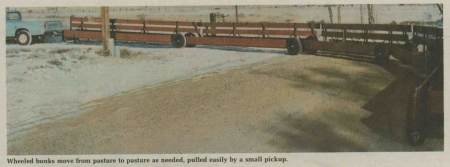
"Everyone who sees it is amazed," says Lee Gibbs, Glendive, Mont., inventor of a new self-cleaning portable feed bunk that travels down the road from pasture to pasture.
The new Porta Bunk is made from treated wood planks fitted to a heavy metal frame. Each 20-ft. section has an axle, outfitted with 14-in. tires, and a tongue that hitches to the bunk in front or to a tractor or pickup used to tow it.
"Cattle feed on the ground wastes 1/4 to 1/3 of their feed due to trampling or moisture on the ground. Our bunks can be moved from pasture to pasture as the ground gets muddy, paying for themselves in feed savings alone," says Gibbs, who's already sold more than 150 bunk sections since he began making them a year ago. He notes that feedlot operators are also interested in the Porta Bunk. "When lots get too muddy, they use the Porta Bunk to move cattle to temporary feeding grounds."
Bunk sections are ganged up in groups of two to five and pulled in one straight line. A line of five feeders is 100 ft. long but Gibbs says he can easily maneuver them in and out of farm buildings and down narrow country roads because each trails directly behind the one in front of it.
"They're so roadworthy I've pulled a 100-ft. length down the road at 50 mph," he says.
To set up the Porta Bunk for feeding, its plank bottoms are dropped to the ground, opening up the bottom of the feeder to make room for a load of hay or silage. To move the feeder, the operator simply cranks the bottoms up and drives away.
"Any feed that cattle don't clean up remains on the ground under the feeder so there's virtually no clean-up and, if it rains, all moisture drains off into the ground and doesn't puddle up in the feeder," says Gibbs, noting that the feeder is built heavy so cattle can't bump it around. "Bump guards keep cattle from getting too close. An added benefit is that they have to reach down for the feed, which helps prevent some respiratory problems."
Cattle feed out of both sides of the feeder so it can be used as a fence or corral divider to separate groups of cattle. It can also be pulled alongside a fence or corral and used as a bunk line feeder.
Gibbs is exploring the possibility of offering a do-it-yourself kit that would include all metal framework needed to build the Porta Bunk, or he may just sell do-it-yourself plans. He is also interested talking to individuals interested in licensing rights to build the feeder.
